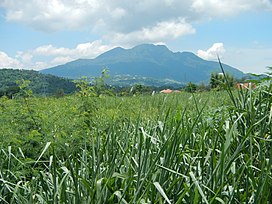| Laguna Volcanic Field | |
|---|---|
| San Pablo Volcanic Field | |
 Mount Makiling, the tallest volcano in the Laguna Volcanic Field Mount Makiling, the tallest volcano in the Laguna Volcanic Field | |
| Highest point | |
| Elevation | 1,090 m (3,580 ft) |
| Coordinates | 14°07′N 121°18′E / 14.12°N 121.30°E / 14.12; 121.30 |
| Geography | |
 | |
| Location | Luzon, Philippines |
| Geology | |
| Rock age | Quaternary |
| Mountain type | Volcanic field |
| Volcanic arc/belt | Macolod Corridor |
| Last eruption | 1350 ± 100 years |
The Laguna Volcanic Field, also known as the San Pablo Volcanic Field, is an active volcanic field in the Philippines, located between Laguna de Bay, Mount Banahaw volcano complex and Mount Malepunyo range. It is part of the larger Southwestern Luzon Volcanic Field (SWLVF). From Manila, it is about 50 kilometres (31 mi) southeast to Mount Makiling, its most prominent volcanic feature.
The field is composed of over 200 dormant and monogenetic maars, crater lakes, scoria cones, and stratovolcanoes, the tallest of which is Mount Makiling at 1,090 m (3,580 ft) in elevation. Many of the maars are aligned along a NE-SW trend. Three generations of maars are present, with the oldest being sediment-filled, like the ones found in Calauan. The youngest maars contain deep lakes with many concentrated in the city of San Pablo. The youngest maar, 1.2-kilometre (0.75 mi) wide Sampaloc Lake was formed about 500–700 years ago according to local legend, the last major activity in the volcanic field.
Volcanism is still evident through the presence of geothermal areas like mud and hot springs. The areas south of Mt. Makiling is the site of one of the earliest geothermal plants in the country.
Volcanic features
The Philippine Institute of Volcanology and Seismology (PHIVOLCS) lists some of the maars and cones situated in the Laguna volcanic field. All are classified as inactive.
Maars
- Alligator Lake, Los Baños 14°10′57″N 121°12′23″E / 14.18250°N 121.20639°E / 14.18250; 121.20639 (Alligator Lake)
- Lake Bunot, San Pablo 14°04′53″N 121°20′38″E / 14.08139°N 121.34389°E / 14.08139; 121.34389 (Lake Bunot)
- Lake Calibato, San Pablo 14°06′12″N 121°22′41″E / 14.10333°N 121.37806°E / 14.10333; 121.37806 (Lake Calibato)
- Lake Gunao, Dolores, Quezon 14°0′4″N 121°22′17″E / 14.00111°N 121.37139°E / 14.00111; 121.37139 (Lake Gunao)
- Imoc Maar, San Pablo 14°6′22″N 121°17′47″E / 14.10611°N 121.29639°E / 14.10611; 121.29639 (Imoc Maar)
- Lake Muhikap, San Pablo 14°7′20″N 121°20′3″E / 14.12222°N 121.33417°E / 14.12222; 121.33417 (Lake Muhikap)
- Lake Palakpakin, San Pablo 14°6′37″N 121°20′24″E / 14.11028°N 121.34000°E / 14.11028; 121.34000 (Lake Palakpakin)
- Lake Pandin, San Pablo 14°6′52″N 121°22′8″E / 14.11444°N 121.36889°E / 14.11444; 121.36889 (Lake Pandin)
- Sampaloc Lake, San Pablo 14°4′42″N 121°19′49″E / 14.07833°N 121.33028°E / 14.07833; 121.33028 (Sampaloc Lake)
- Lake Tikub, Tiaong, Quezon 13°57′46″N 121°18′23″E / 13.96278°N 121.30639°E / 13.96278; 121.30639 (Lake Tikub)
- Lake Yambo, San Pablo 14°07′9″N 121°21′59″E / 14.11917°N 121.36639°E / 14.11917; 121.36639 (Lake Yambbo)
- Dolotina Maar, San Pablo 14°5′58″N 121°17′53″E / 14.09944°N 121.29806°E / 14.09944; 121.29806 (Dolotina Maar)

Cones
- Named as hills
- Bayaquitos Hill, Nagcarlan 14°9′20.2″N 121°23′17.8″E / 14.155611°N 121.388278°E / 14.155611; 121.388278 (Bayaquitos Hill)
- Bunsulan Hills, Alaminos 14°02′6.2″N 121°14′19.7″E / 14.035056°N 121.238806°E / 14.035056; 121.238806 (Bunsulan Hills)
- La Mesa Hill, Calamba 14°8′56.7″N 121°9′50.5″E / 14.149083°N 121.164028°E / 14.149083; 121.164028
- Mani Hill, Alaminos 14°02′10.2″N 121°15′43.5″E / 14.036167°N 121.262083°E / 14.036167; 121.262083
- Mapait Hills, Alaminos 14°2′40.9″N 121°14′15.2″E / 14.044694°N 121.237556°E / 14.044694; 121.237556
- Mayondon Hill, Los Baños 14°11′44.9″N 121°14′16.9″E / 14.195806°N 121.238028°E / 14.195806; 121.238028
- Palindan Hill, Alaminos 14°1′49.9″N 121°15′19.6″E / 14.030528°N 121.255444°E / 14.030528; 121.255444
- Tanza Hill, Alaminos 14°02′2.5″N 121°15′29.4″E / 14.034028°N 121.258167°E / 14.034028; 121.258167
- Named as mountains
- Mount Atimla, Nagcarlan 14°8′56.3″N 121°21′56.21″E / 14.148972°N 121.3656139°E / 14.148972; 121.3656139 (Mt. Atimla)
- Mount Bayaquitos, Nagcarlan 14°9′23.1″N 121°23′46.0″E / 14.156417°N 121.396111°E / 14.156417; 121.396111 (Mt. Bayaquitos)
- Mount Bijiang, Calamba 14°9′41.5″N 121°9′58.4″E / 14.161528°N 121.166222°E / 14.161528; 121.166222 (Mt. Bijiang)
- Mount Buboy, Calauan 14°05′47.0″N 121°14′36.9″E / 14.096389°N 121.243583°E / 14.096389; 121.243583 (Mt. Buboy)
- Mount Bulalo, Calauan 14°6′4.5″N 121°13′34.5″E / 14.101250°N 121.226250°E / 14.101250; 121.226250
- Mount Cabulugan, Bay 16°7′6.2″N 121°12′50″E / 16.118389°N 121.21389°E / 16.118389; 121.21389
- Mount Camotes, Calamba 14°9′43.6″N 121°9′8.2″E / 14.162111°N 121.152278°E / 14.162111; 121.152278
- Mount Kalisungan, Calauan 14°8′48.2″N 121°20′41.0″E / 14.146722°N 121.344722°E / 14.146722; 121.344722
- Mount Lagula, Calauan 14°07′27.2″N 121°19′19.3″E / 14.124222°N 121.322028°E / 14.124222; 121.322028
- Mount Lansay, Nagcarlan 14°7′37″N 121°23′59″E / 14.12694°N 121.39972°E / 14.12694; 121.39972
- Mount Luyong, Calauan 14°06′34.3″N 121°14′45.5″E / 14.109528°N 121.245972°E / 14.109528; 121.245972
- Mount Mabilog, San Pablo 14°06′20.6″N 121°15′40.9″E / 14.105722°N 121.261361°E / 14.105722; 121.261361
- Mount Malauban, San Pablo 14°7′5.0″N 121°22′16.2″E / 14.118056°N 121.371167°E / 14.118056; 121.371167
- Mount Malauban-Lansay, San Pablo 14°7′12.2″N 121°22′59.0″E / 14.120056°N 121.383056°E / 14.120056; 121.383056
- Mount Mapula, Calauan 14°05′55″N 121°16′50.9″E / 14.09861°N 121.280806°E / 14.09861; 121.280806
- Mount Masaia, Calamba 14°9′12.0″N 121°9′21.4″E / 14.153333°N 121.155944°E / 14.153333; 121.155944
- Mount Obabis, Calauan 14°6′45.5″N 121°18′15.4″E / 14.112639°N 121.304278°E / 14.112639; 121.304278
- Mount Olila, Alaminos 14°04′40.2″N 121°12′52.1″E / 14.077833°N 121.214472°E / 14.077833; 121.214472
- Mount Tamlong, Calauan 14°4′55.7″N 121°14′26.7″E / 14.082139°N 121.240750°E / 14.082139; 121.240750
See also
External links
References
- ^ "San Pablo Volcanic Field". Global Volcanism Program. Smithsonian Institution. Retrieved October 11, 2013..
- ^ Rene Juna R. Claveria, Teresita R. Perez, etc. "Petrographic Analysis of Rocks and Sediments around the Seven Lakes of San Pablo, Laguna: Implications Regarding Sulfate Distribution and Provenance". Department of Environmental Science, Ateneo de Manila University. Retrieved October 11, 2013.
{{cite web}}: CS1 maint: multiple names: authors list (link) - "Inactive Volcanoes – Part 1" Archived September 24, 2015, at the Wayback Machine. Philippine Institute of Volcanology and Seismology. Retrieved on October 13, 2013.
| Volcanoes of the Philippines | |||||||
|---|---|---|---|---|---|---|---|
| Active volcanoes |
| ||||||
| Potentially active volcanoes | |||||||
| See also: List of mountains in the Philippines | |||||||